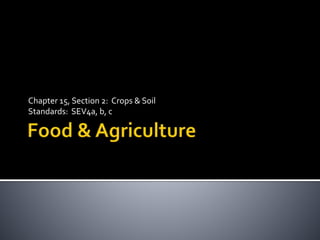
Unit 6 ch 15 s2 crops & soil
- 1. Chapter 15, Section 2: Crops & Soil Standards: SEV4a, b, c
- 2. Land that can be used to grow crops Only 10% of land on earth is arable. Urban areas occupy 3% and are currently invading arable land.
- 3. Traditional Agriculture Plows pulled by animals to turn & loosen soil. Organic fertilizer (animal manure) used to enrich soil for plant growth. Drainage ditches were dug to bring water to plants for irrigation. Weeds pulled by hand.
- 4. ModernAgriculture Large machines plow land and harvest crops. Synthetic chemical fertilizers used instead of manure Overhead sprinklers & drip systems irrigate crops Synthetic chemical pesticides are used to kill pests The chemical fertilizer & pesticides are often oil based.
- 5. Rock breaks down into fine particles and mix with decomposing matter to make topsoil. ChemicalWeathering Rock is broken down by chemical rxn btwn water & a substance in rock that can be dissolved ▪ EX: Lichen secrete acids that break rock down PhysicalWeathering Water Wind Bacteria, fungi, earthworms all break down dead matter & recycle nutrients back to soil. Earthworm burrows allow air to circulate in soil
- 6. Surface litter/Organic layer- leaf litter, partially decomposed organic matter Topsoil- organic matter, living organisms, fine rock particles; also water & air Subsoil- larger rock particles, some organic matter, mostly inorganic compounds Parent Rock- bedrock that has been weathered Bedrock- solid rock layer
- 7. Erosion Movement of rock & soil by wind or water ½ of topsoil in US has eroded- affects ability to grow crops Farming increases rate of erosion through plowing & irrigation Desertification Land in arid/semi-arid areas becomes more desert-like Due to overgrazing & planting too many crops Salinization Soil too salty to grow plants in. Becomes salty from ▪ Over-irrigation ▪ Low rainfall Flooding field with freshwater can remove excess salt White salt deposits on cropland
- 8. Terracing- cutting levels into steep hillside to slow water erosion Contour plowing- plowing across hill on gentle slope to slow water erosion Strip plowing- leaving strips of vegetation in every other row so roots hold soil in place
- 9. Drip irrigation- using series of hoses to drip water around plant roots; expensive but very effective No-till harvesting- harvesting crop without turning soil. Roots hold soil to prevent erosion Cons- old crop might crowd out new crop and decrease crop yields
- 10. Crop Rotation- Rotating crops to replenish nutrients in soil. ▪ Corn crops remove nutrients from soil so planting a crop of soybean the next year will replenish those nutrients back to the soil. Compost Partly decomposed organic matter from yard waste, home food waste, or crop waste Added with chemical fertilizers to enrich soil.
- 11. Explain the difference between traditional and modern farming methods. Describe the structure and composition of fertile soil. Explain why the presence of plants helps prevent soil erosion. Explain why soil conservation is an important agricultural practice.